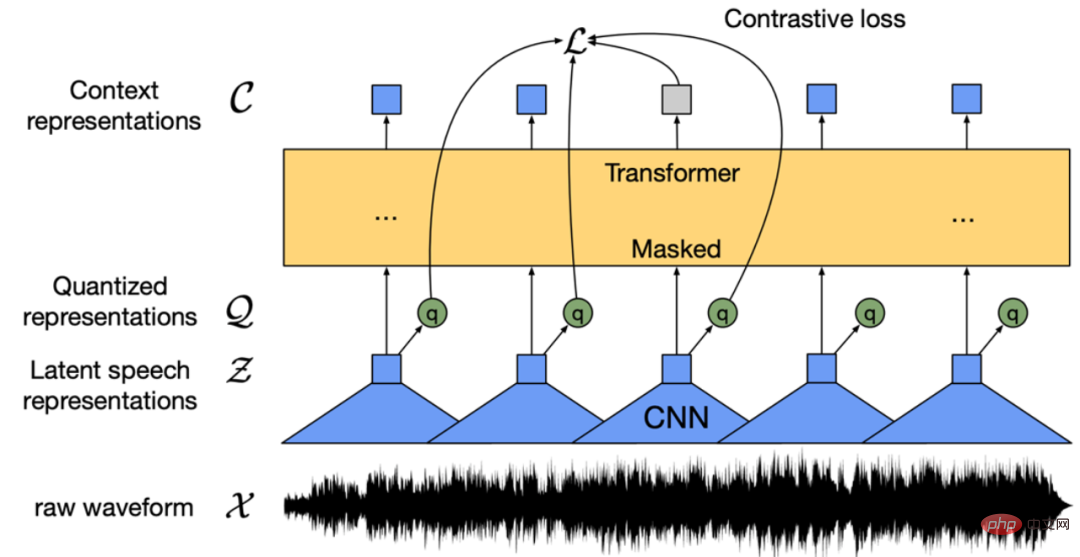 Technology peripherals
Technology peripherals AI
AI More accurate and minimally invasive than Musk's brain-computer interface, the ultrasound brain reading method is here
More accurate and minimally invasive than Musk's brain-computer interface, the ultrasound brain reading method is hereThere is new news coming out of the brain-computer interface track.
IEEE Spectrum news, a new minimally invasive ultrasound brain-computer interface device is under development.

This device changes the traditional brain-computer interface medium EEG to ultrasound.
The principle is to use direct focused ultrasound (FUS) to change the action potential of neurons, using a technology called Functional Ultrasound Imaging (fUSI), through the Doppler effectMeasure local blood flow changes to monitor neural activity within brain regions.
Medical technology company Forest Neurotech and medical imaging company Butterfly Network have reached a cooperation on the development of this minimally invasive ultrasound brain-computer interface device.
In terms of developing brain-computer interfaces, Musk's Neuralink, Paradromics and Synchron and other companies are all working hard to "electrically" interact with the brain
In comparison, ultrasound-based brain-computer interfaces What are the advantages of interfaces?
The "wound" is smaller and the spatial positioning is more accurate
According to reports, traditional brain electrical stimulation technology is highly restricted in space due to the limited propagation distance of current in brain tissue. According to the above, traditional brain electrical stimulation technology is greatly restricted in space due to the limited distance that electric current propagates in brain tissue. Therefore, when stimulating deep areas of the brain, it is necessary to invade through
Sexual SurgeryPlace electrodes in relevant locations. And simply installing deep implants or electrodes in the skull can only record neural activity in superficial areas of the brain. To this end, the development team stated that it is developing a minimally invasive ultrasound implant. It only needs to be implanted into the user's skull and placed on the surface of the brain to use ultrasound to flexibly stimulate and record specific areas of the brain. Neural activity, and the accuracy is
sub-millimeter level.
 Specifically, Butterfly Network provides ultrasound chip hardware support, and Forest Neurotech uses these ultrasound chips to stimulate specific areas of the brain through guided and focused ultrasound waves.
Specifically, Butterfly Network provides ultrasound chip hardware support, and Forest Neurotech uses these ultrasound chips to stimulate specific areas of the brain through guided and focused ultrasound waves.
 Next, use functional ultrasound imaging (fUSI), a neuroimaging technology, to monitor neural activity
Next, use functional ultrasound imaging (fUSI), a neuroimaging technology, to monitor neural activity
The principle of fUSI is also very simple:
Like all cells, neurons require blood to function, and an increase in the "activity" of neurons means that the blood flow supply required by the brain also increases.
fUSI uses ultrasound to detect small changes in blood flow in the brain to infer the activity level of neurons
The specific method is to emit ultrasound waves to a certain area of the brain and then detect its "echo" ( That is, reflected waves affected by blood flow) to achieve
Since blood will cause the "Doppler effect" when it moves, it will slightly affect the vibration frequency of the echo.
By analyzing changes in echo frequency, the fUSI system can infer changes in blood flow velocity, thereby inferring neural activity in the area
Company Profile
It is reported that this The first ultrasound brain-computer interface device will be jointly developed by Forest Neurotech and Butterfly Network.
Forest Neurotechis a non-profit organization just established in January this year, focusing on the development of minimally invasive ultrasound brain-computer interfaces. The co-founders are Sumner L. Norman, Tyson Aflalo, and William Biederman.
 The fUSI technology mentioned above is a research that CEO Sumner L. Norman recently participated in.
The fUSI technology mentioned above is a research that CEO Sumner L. Norman recently participated in.
 In addition, Forest Neurotech is a subsidiary of Convergent Research, which is a scientific non-profit incubator and a member of the Schmidt Futures Network. It was announced some time ago that it has received 5,000 $10,000 in new philanthropic support.
In addition, Forest Neurotech is a subsidiary of Convergent Research, which is a scientific non-profit incubator and a member of the Schmidt Futures Network. It was announced some time ago that it has received 5,000 $10,000 in new philanthropic support.
is a medical imaging unicorn company founded in 2011 by Jonathan Rothberg, known as the "Jobs of biotechnology." Butterfly Network previously developed Butterfly iQ, the first handheld single-probe whole-body ultrasound system built using ultrasound chip technology
Currently, Forest Neurotech has reached a 5-year joint development agreement with Butterfly Network , Forest will pay US$20 million to purchase Butterfly ultrasound chips and services.
The above is the detailed content of More accurate and minimally invasive than Musk's brain-computer interface, the ultrasound brain reading method is here. For more information, please follow other related articles on the PHP Chinese website!
 解读CRISP-ML(Q):机器学习生命周期流程Apr 08, 2023 pm 01:21 PM
解读CRISP-ML(Q):机器学习生命周期流程Apr 08, 2023 pm 01:21 PM译者 | 布加迪审校 | 孙淑娟目前,没有用于构建和管理机器学习(ML)应用程序的标准实践。机器学习项目组织得不好,缺乏可重复性,而且从长远来看容易彻底失败。因此,我们需要一套流程来帮助自己在整个机器学习生命周期中保持质量、可持续性、稳健性和成本管理。图1. 机器学习开发生命周期流程使用质量保证方法开发机器学习应用程序的跨行业标准流程(CRISP-ML(Q))是CRISP-DM的升级版,以确保机器学习产品的质量。CRISP-ML(Q)有六个单独的阶段:1. 业务和数据理解2. 数据准备3. 模型
 人工智能的环境成本和承诺Apr 08, 2023 pm 04:31 PM
人工智能的环境成本和承诺Apr 08, 2023 pm 04:31 PM人工智能(AI)在流行文化和政治分析中经常以两种极端的形式出现。它要么代表着人类智慧与科技实力相结合的未来主义乌托邦的关键,要么是迈向反乌托邦式机器崛起的第一步。学者、企业家、甚至活动家在应用人工智能应对气候变化时都采用了同样的二元思维。科技行业对人工智能在创建一个新的技术乌托邦中所扮演的角色的单一关注,掩盖了人工智能可能加剧环境退化的方式,通常是直接伤害边缘人群的方式。为了在应对气候变化的过程中充分利用人工智能技术,同时承认其大量消耗能源,引领人工智能潮流的科技公司需要探索人工智能对环境影响的
 找不到中文语音预训练模型?中文版 Wav2vec 2.0和HuBERT来了Apr 08, 2023 pm 06:21 PM
找不到中文语音预训练模型?中文版 Wav2vec 2.0和HuBERT来了Apr 08, 2023 pm 06:21 PMWav2vec 2.0 [1],HuBERT [2] 和 WavLM [3] 等语音预训练模型,通过在多达上万小时的无标注语音数据(如 Libri-light )上的自监督学习,显著提升了自动语音识别(Automatic Speech Recognition, ASR),语音合成(Text-to-speech, TTS)和语音转换(Voice Conversation,VC)等语音下游任务的性能。然而这些模型都没有公开的中文版本,不便于应用在中文语音研究场景。 WenetSpeech [4] 是
 条形统计图用什么呈现数据Jan 20, 2021 pm 03:31 PM
条形统计图用什么呈现数据Jan 20, 2021 pm 03:31 PM条形统计图用“直条”呈现数据。条形统计图是用一个单位长度表示一定的数量,根据数量的多少画成长短不同的直条,然后把这些直条按一定的顺序排列起来;从条形统计图中很容易看出各种数量的多少。条形统计图分为:单式条形统计图和复式条形统计图,前者只表示1个项目的数据,后者可以同时表示多个项目的数据。
 自动驾驶车道线检测分类的虚拟-真实域适应方法Apr 08, 2023 pm 02:31 PM
自动驾驶车道线检测分类的虚拟-真实域适应方法Apr 08, 2023 pm 02:31 PMarXiv论文“Sim-to-Real Domain Adaptation for Lane Detection and Classification in Autonomous Driving“,2022年5月,加拿大滑铁卢大学的工作。虽然自主驾驶的监督检测和分类框架需要大型标注数据集,但光照真实模拟环境生成的合成数据推动的无监督域适应(UDA,Unsupervised Domain Adaptation)方法则是低成本、耗时更少的解决方案。本文提出对抗性鉴别和生成(adversarial d
 数据通信中的信道传输速率单位是bps,它表示什么Jan 18, 2021 pm 02:58 PM
数据通信中的信道传输速率单位是bps,它表示什么Jan 18, 2021 pm 02:58 PM数据通信中的信道传输速率单位是bps,它表示“位/秒”或“比特/秒”,即数据传输速率在数值上等于每秒钟传输构成数据代码的二进制比特数,也称“比特率”。比特率表示单位时间内传送比特的数目,用于衡量数字信息的传送速度;根据每帧图像存储时所占的比特数和传输比特率,可以计算数字图像信息传输的速度。
 数据分析方法有哪几种Dec 15, 2020 am 09:48 AM
数据分析方法有哪几种Dec 15, 2020 am 09:48 AM数据分析方法有4种,分别是:1、趋势分析,趋势分析一般用于核心指标的长期跟踪;2、象限分析,可依据数据的不同,将各个比较主体划分到四个象限中;3、对比分析,分为横向对比和纵向对比;4、交叉分析,主要作用就是从多个维度细分数据。
 15年软件架构师经验总结:在ML领域,初学者踩过的五个坑Apr 11, 2023 pm 07:31 PM
15年软件架构师经验总结:在ML领域,初学者踩过的五个坑Apr 11, 2023 pm 07:31 PM数据科学和机器学习正变得越来越流行,这个领域的人数每天都在增长。这意味着有很多数据科学家在构建他们的第一个机器学习模型时没有丰富的经验,而这也是错误可能会发生的地方。近日,软件架构师、数据科学家、Kaggle 大师 Agnis Liukis 撰写了一篇文章,他在文中谈了谈在机器学习中最常见的一些初学者错误的解决方案,以确保初学者了解并避免它们。Agnis Liukis 拥有超过 15 年的软件架构和开发经验,他熟练掌握 Java、JavaScript、Spring Boot、React.JS


Hot AI Tools

Undresser.AI Undress
AI-powered app for creating realistic nude photos

AI Clothes Remover
Online AI tool for removing clothes from photos.

Undress AI Tool
Undress images for free

Clothoff.io
AI clothes remover

AI Hentai Generator
Generate AI Hentai for free.

Hot Article

Hot Tools

SAP NetWeaver Server Adapter for Eclipse
Integrate Eclipse with SAP NetWeaver application server.

MinGW - Minimalist GNU for Windows
This project is in the process of being migrated to osdn.net/projects/mingw, you can continue to follow us there. MinGW: A native Windows port of the GNU Compiler Collection (GCC), freely distributable import libraries and header files for building native Windows applications; includes extensions to the MSVC runtime to support C99 functionality. All MinGW software can run on 64-bit Windows platforms.

VSCode Windows 64-bit Download
A free and powerful IDE editor launched by Microsoft

MantisBT
Mantis is an easy-to-deploy web-based defect tracking tool designed to aid in product defect tracking. It requires PHP, MySQL and a web server. Check out our demo and hosting services.

mPDF
mPDF is a PHP library that can generate PDF files from UTF-8 encoded HTML. The original author, Ian Back, wrote mPDF to output PDF files "on the fly" from his website and handle different languages. It is slower than original scripts like HTML2FPDF and produces larger files when using Unicode fonts, but supports CSS styles etc. and has a lot of enhancements. Supports almost all languages, including RTL (Arabic and Hebrew) and CJK (Chinese, Japanese and Korean). Supports nested block-level elements (such as P, DIV),






